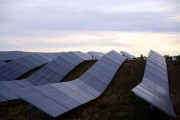While spring in Ontario has yet to bring much rain, there’s been no shortage of mudslinging over rising electricity prices. While there’s more to these changes than critics of renewable energy would you have you believe, new data helps to clarify how recent prices have more to do with nuclear than with clean energy programs.
To start, electricity prices are going to go up no matter what source of energy we choose to use. Half of the province’s electricity system’s generating capacity – including almost every nuclear reactor – needs to be replaced or rebuilt within the next 10 years and you simply cannot power plants in 2012 at 1980’s prices.
While it’s the only province to reap the benefits of phasing out coal, price increases are by no means exclusive to Ontario. In coal-powered Alberta, prices are forecast to rise by 50 per cent between 2010 and 2016. Between 2002 and 2010, rates in Nova Scotia rose by 37 per cent. In Saskatchewan they rose by 36 per cent. And BC Hydro forecasts a rate increase of 32 per cent between 2011 and 2014.
What seems to be unique to Ontario is the fear that renewable energy is the sole cause of the increase. Although Ontario’s ambitious clean energy development targets are being met by establishing contracts with renewable energy generators in the form feed-in tariffs (FIT), the province has similar long-term contracts with both nuclear and gas powered plants.
The difference with renewable energy, however, is that FIT prices are fully disclosed, while the same cannot be said for nuclear, or many of the province’s gas contracts. Ironically, it’s this transparency that seems to put renewable energy at a disadvantage, allowing critics to do what they will with the data while prices for other energy sources slip under the radar.
Making sense of the market
While FITs are transparent, it can be difficult to understand their impact on Ontario’s electricity market, in part because it really isn’t much of a “market” at all. Huge assets of Ontario’s electricity grid remain under the ownership of Ontario Power Generation (OPG) as well as other private companies, and adjustments to your electricity bill ensure they get paid if market prices drop.
New data from the Ontario Energy Board’s market surveillance report shows that the power providers who have received the largest portion of these adjustments since 2006 aren’t wind and solar energy — they only account for six per cent. Instead, it’s nuclear, at 45 per cent. Given that nuclear energy accounts for over half of Ontario’s electricity consumption, this is hardly surprising.
As more renewable energy enters the grid and gains a larger percentage of provincial contracts, future price increases will have more to do with renewable energy generators. But for now, the bigger player in the system (i.e., nuclear) is also the biggest price setter.
The good news with renewables is that, as more come online, the FIT prices will decrease. This model has driven solar prices down by 50 per cent in Europe over the past five years, and Ontario’s recent price adjustments show the same thing is happening here.
Missing numbers for nuclear and natural gas
No one is hiding the fact that Ontario is currently paying a premium to get the ball rolling with renewable energy. What’s not being discussed, is the cost of alternatives to renewable energy, since doing nothing is not an option.
At the Pembina Institute we completed a study that found that cancelling the FIT would barely slow price increases in the near term, culminating in a monthly savings of about $4 for typical household hydro bill, at most. In the longer term, however, stable renewable energy prices are likely to save consumers money, as the price of gas is expected to increase, while the wind blows and the sun shines for free.
That said, we know even less about the cost of a continued commitment to nuclear power, currently forecast to be 50 per cent of Ontario’s future supply. Almost all of the province’s nuclear units need major work, — or in the case of Pickering, a complete shut-down — yet the full costs associated with refurbishing existing units or building new ones has never been made public. Given the history of cost and time overruns in Ontario, and recently in New Brunswick and Quebec, price watchers ought to be asking for at least the same transparency and price guarantees that renewable energy offers.
While there’s little respite from rising electricity prices no matter what the source, with renewable energy at least consumers know what they’re paying for.







